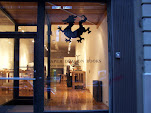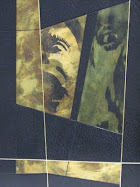



Finally its here, covered, the books are ready for the really fun part(!?!)...Finishing.
Before I get to the prep.work, the best way to proceed is to work out what tools I'm going to use.
I don`t have an ink pad, so I make mock spines and boards, and use foil to mark-up for tooling.
Now I`m not one to blame my shortcomings on my tools, but succesfull period binding depends on having the correct tools for the job.
My fledgling collection certainly is far from complete(3 sets of corner tools , and 3 center tools!!)but a trip downstairs to the ever accomodating Aaron at Talas, soon puts that right.I love now that if I need anything I can pop downstairs and see the neighbours, and I`m sure they don`t mind either.....the jury is out on what Denise might have to say!
On the upside, I think I've been shrewd in choosing the wheels(the wall is almost there!).A lot of Bindings in the 18thcentury are characterised by fat rolls of gold decoration along the edges of the boards,fillets, with centre designs such as harlequins,ovals,varios seals , with some designs covering the expanse of the binding.I know what I`m not doing, that is, any tree-marbling, or onlay work, and there will no pattern made-up of individual hand tools.On the front and back boards I'm going to do a panelled pattern, minus the corner and side tools.I don't have a really fat wheel, but what i do have are wheels, that I can double-up and reverse tool(Doubling the size of the pattern).
When I've worked all that out, it's time to make the parchment size , to be used instead of the paste wash for goat.You can get the parchment scraps by weight from talas, cut them up into bits of approx. 20x20mm , boil them gradually reducing the liquid to a viscous gelatine size, usefull for some edge decoration too.
The books get two coats of the size and two coats of glaire(shellac based).
*nb only prep.what you can handle completing in a day.I split the work in 2 days between boards and spines.When its done, the turn-ins get a Dentelle of the outside wheel doubled again in blind.The ends put down, the books pressed, and finally the boards polished with a wax emulsion.
*nb, you don't need to polish the spines...... you don't......unless you want all that finishing to crack off !
Just in time for the show........
bibliog:"bookbinding"(arthur w johnson)
"the history of decorated bookbinding in england" (nixon and foot)
"james scott and william scott bookbinders"(j h loudon)






























